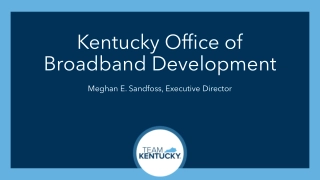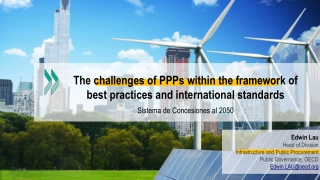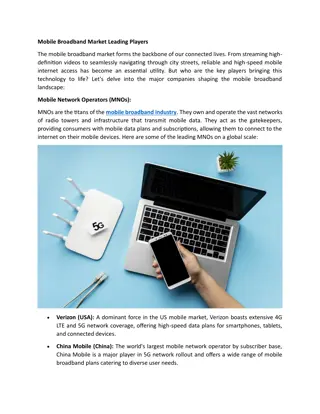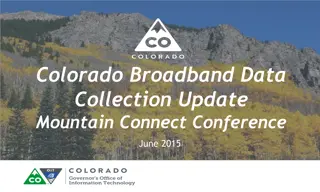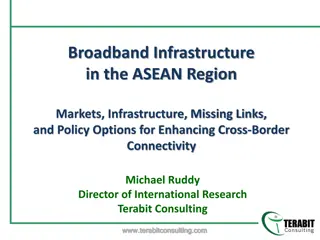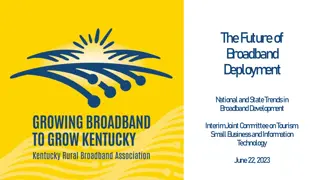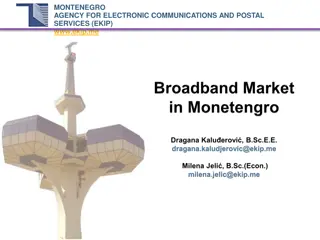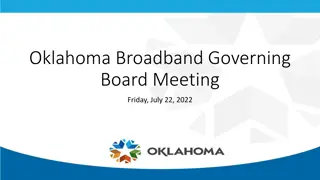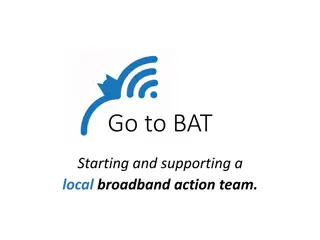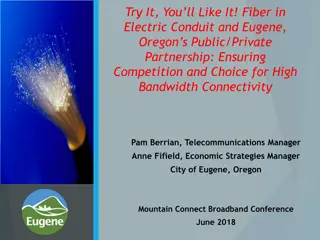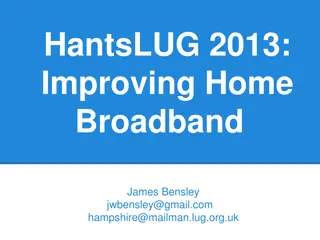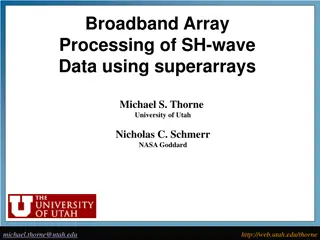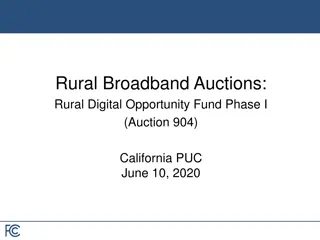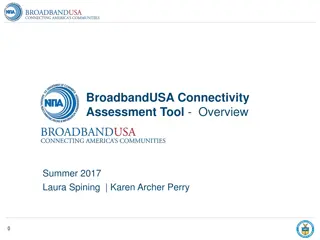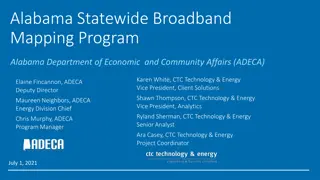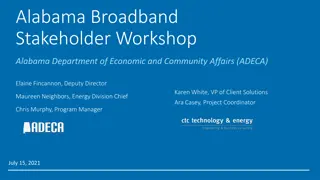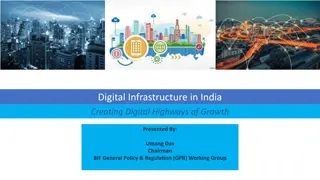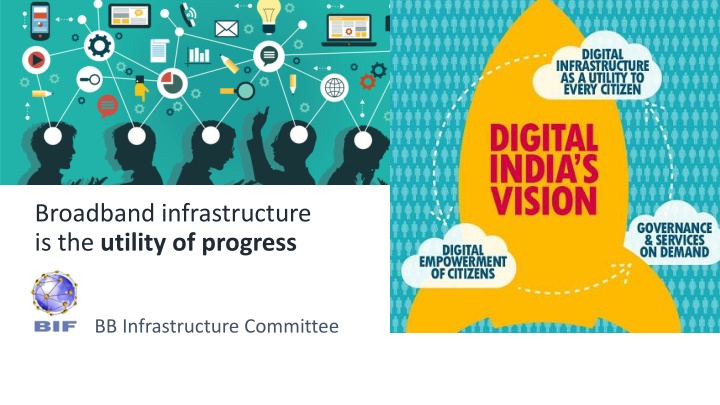
Transformative Power of Broadband Infrastructure
Digital India leverages broadband infrastructure as the cornerstone for progress, driving socio-economic growth and revolutionizing connectivity. The robust network facilitates real-time interactions, improves GDP, enhances health and education services, fosters entrepreneurship, and spurs job creation. Hyper-connectivity and ultra-low latency technologies demand cutting-edge infrastructure, with 5G poised to unlock new possibilities in autonomous driving, virtual reality, and more. The shift towards 5G will necessitate significant fiber backhaul, signaling a monumental change in global fiber infrastructure. Governments must incentivize the rapid expansion of fiber networks to support the evolving digital landscape.
Download Presentation

Please find below an Image/Link to download the presentation.
The content on the website is provided AS IS for your information and personal use only. It may not be sold, licensed, or shared on other websites without obtaining consent from the author. If you encounter any issues during the download, it is possible that the publisher has removed the file from their server.
You are allowed to download the files provided on this website for personal or commercial use, subject to the condition that they are used lawfully. All files are the property of their respective owners.
The content on the website is provided AS IS for your information and personal use only. It may not be sold, licensed, or shared on other websites without obtaining consent from the author.
E N D
Presentation Transcript
Broadband infrastructure is the utility of progress BB Infrastructure Committee
Digital India with strength of BB infra will create a tectonic shift to achieve SDG goals It is the ONLY infrastructure that delivers real time connect in India and the world 10% increase in BB penetration will lead to 1.38% GDP increase Health, education, entrepreneurship, New jobs and must be viewed for its socio economic impact Connected base for optimizing other utilities (electricity, water, traffic) Transparent and smarter Govt. citizen engagement (city-rural connect, Taxes, subsidies, governance, forums) Citizens right to data access is PIVOTAL to Life & Lifestyle
technology applications built today will need hyper connectivity and ultra low latency Autonomous Driving 1 ms Virtual Reality Augmented Reality Tactile Internet ULTRA LOW LATENCY 10 ms Disaster Alert Real Time Gaming Delay 100 ms Wireless Cloud based Office Personal Cloud 1000 ms Video Streaming HYPER CONNECTIVITY <1 Mbps 1 Mbps 10 Mbps 100 Mbps >1 Gbps Bandwidth On the Go (Fully Mobile) Nomadic (Fixed Access with Limited Mobility) Source: GSMA
5G penetration with Indias scale can establish new possibilities Autonomous Driving 1 ms Virtual Reality Augmented Reality Tactile Internet ULTRA LOW LATENCY 10 ms Disaster Alert Real Time Gaming Delay 100 ms Wireless Cloud based Office Personal Cloud 1000 ms Video Streaming HYPER CONNECTIVITY <1 Mbps 1 Mbps 10 Mbps 100 Mbps >1 Gbps Bandwidth On the Go (Fully Mobile) Nomadic (Fixed Access with Limited Mobility) Enabled by 5G Source: GSMA
5G would create strong demand for fibre backhaul Implications on fibre requirements 5G deployments will require fiber for backhaul: backhaul will constitute 15- 30% of 5G deployment costs 5G will require 20-30x the number of cells of a conventional cellular network Typical LTE cell coverage Typical 5G cell coverage Fiber requirements for 5G likely to be 3- 5X for same coverage for 4G in the massive MIMO mode This increased demand for fiber will result in massive (order of magnitude) change in the fiber infrastructure of several countries US, Western Europe, Japan, Korea to start followed by China, India, Latam, Eastern Europe ~550+ Meters1 ~100 Meters2 Governments will need to play a critical role in providing incentives for enabling the same 1 For typical 2.1 GHz LTE base station in urban area 2 For 5G small cell based on >5GHz+ spectrum in urban area Source: McKinsey
Focus on foundation- Fibre critical for high data volumes Now, Fibre is geeting closer to the customer 2G Era 3G Era 4G Era 5G + FTTH Era Major cities Fibre is connecting: most cities, towns, sub-urban areas between towers, as backhaul small cells, buildings, homes Being deployed by: Conventional Telcos CSPs / DSPs OTTs and Content Players
Current infrastructure challenges are significant a. Digital India depends on broadband infrastructure b. BB Definition very low compared to the ambitious plans of India c. Focus on foundation- Fiberisation is a challenge d. Broadband density stands at ~ 20% today. Significant impetus needed e. Lack of funding for Fibre, Tower, new technologies). no Infra Fund. f. No legal protection available to BB infrastructure (fibre, towers). g. Buildings do not have BB access h. No Central held Guidelines given massive roll outs in rural, urban, borders and smart cities i. Implementation of ROW policy continues to be a barrier.
Infrastructure is way below the mark % of Telecom Towers Fiberized <20% 65-70% 75-80% India Korea (SEA) US, China, Jap Population (Mn) vs Cumulative Fiber Deployed (Mn Fkm) Fiberization of infrastructure critical to address thedata revolution Source: CRU, Wikipedia, Deloitte, Akamai
Broadband infrastructure central to India s growth: inflection point NTP infrastructure objectives must include 4 principles EXPAND PROTECT SUSTAIN DE-RISK
1. Facilitate the expansion of Infrastructure Frame an ambitious definition of BB speed and access for urban and rural Households Ensure easy funding avenues to the sector: a. Setup a government led telecom infrastructure fund b. Permit telecom sector to issue tax-free bonds and access long-term low-cost debt from Infra Debt Funds. c. Increase planned union budget allocation by a percentage of GDP for the proliferation of BB access Resolve ROW issues a. Classify types of Cities and specify the levies/fees for each type of city b. Create a joint Centre-State council to resolve the issues along the lines of the GST Council. c. Mandate utility corridors in new roads and infrastructure to reduce time and cost involved in ROW Mandate deployment of CTI (Common Telecom Infrastructure) while constructing all/any new highways, roads, and civil infrastructure along with that of other utilities. Incentivize Utilities to become IP1s and strengthen business models towards shared infrastructure for services EXPAND PROTECT SUSTAIN Include FTTH in building codes for certification of new buildings DE-RISK
1. Facilitate the expansion of Infrastructure by addressing ease of doing business with Govt deployments a. Ease and synergise execution, document and cash process by leveraging technology b. Push for the importance of quality selection criteria of vendors c. Operate from stringent standards and strong penalties to reduce audit touchpoints. Permissions - effective synergies for on time and reduced process grunge a. A single window clearance for permissions b. Deemed approval on all relevant govt. land c. ROW nodal agency that manages all permissions will reduce time, effort and cost. d. Govt. focus on transforming accounting practices and bringing cross ministerial synergies The opportunity cost can be better utilized to pace up quality roll outs of NWs. Approvals - efficiencies and reduction of human touchpoints in execution, documentation and cash flow a. Stringent vendor selection criteria b. Focus on operating from standards and strong SLAs c. Efficient utilisation of technology and surveillance for approvals d. Strong audit and penalties to ensure quality is adhered to e. A framework to synergise execution, documentation and payments to ensure optimisation of time, effectiveness and resource. EXPAND PROTECT SUSTAIN DE-RISK
2. Focus on protection ofthe Infrastructure a. Designate BB infrastructure as critical infrastructure and provide fiscal incentives applicable to infrastructure designated sectors b. Secure network by creating centrally held procurement and deployment standards c. Mandate GIS mapping, call before you dig . d. Provide regulatory support to protect existing telecom infrastructure (eg. penalize damage to towers, fiber etc.) EXPAND PROTECT SUSTAIN DE-RISK
3. Ensure de-risking the Infrastructure a. Practices like mirror architecture, mesh or ring fibre, new technology must be encouraged b. Top quality roll out with outcome based standards c. Ensure equipment is technology agnostic with Cluster based strategy d. New technology pilots must be encouraged to ensure easy adoption of new technologies. e. Encourage innovative approaches to infrastructure creation and access including through Resale, Wi- Fi, Opening Digital Terrestrial Transmitters and Virtual Network Operators BB Infrastructure commission : Cross ministerial similar to GST commission. EXPAND Infrastructure CXO council under the office of the Secretary that reviews infrastructure progress twice a year. Critical Govt. officials should be a part. PROTECT SUSTAIN DE-RISK
4. Encourage sustainable practices a. Incentivize sustainable telecommunications (Green Telecom) b. Synergize power and energy policy towards BB infra to increase availability of alternate and renewable energies c. Set standards for sustainable practices including procurement, disposing, Zero carbon emission by 2022, in line with the across industry practice (power/energy) d. Incentivse usage of equipment with a sustainable track record EXPAND PROTECT SUSTAIN DE-RISK
Thank You and discussion! 4 infrastructure principles EXPAND PROTECT SUSTAIN DE-RISK

